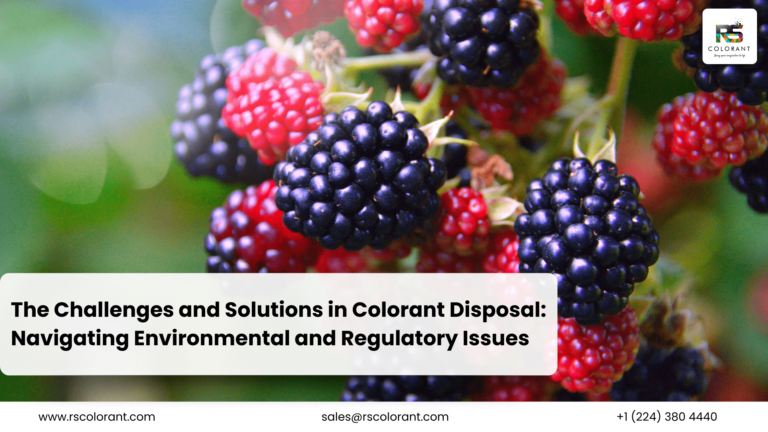Eco-Friendly Colorants – Outline
The Role of Colorants in Eco-Friendly Products
Introduction
The world is becoming increasingly aware of the environmental impact of consumer products. As a result, eco-friendly products have surged in popularity. But did you know that colorants play a significant role in making these products attractive to consumers? Let’s delve into the fascinating world of colorants and their role in eco-friendly products.
Understanding Colorants
What are Colorants?
Colorants are substances used to impart color to various products, ranging from textiles and food to cosmetics and household items. They come in different forms, including dyes, pigments, and lakes.
Types of Colorants
Natural Colorants: Derived from plants, minerals, and animals, natural colorants have been used for centuries. They are prized for their minimal environmental impact and biodegradability.
Synthetic Colorants: These are man-made chemicals designed to provide vibrant and consistent colors. However, their production and disposal can harm the environment.
Environmental Impact of Traditional Colorants
Traditional synthetic colorants are often laden with harmful chemicals. When released into the environment, they can cause significant pollution, contaminating water sources and harming aquatic life. Moreover, some synthetic colorants are known to be carcinogenic, posing health risks to humans.
Benefits of Eco-Friendly Colorants
Reduced Environmental Footprint
Eco-friendly colorants are designed to minimize environmental impact. They are typically biodegradable, reducing pollution and preserving ecosystems.
Health Benefits for Consumers
Natural colorants are less likely to contain harmful chemicals, making products safer for consumers, especially those with allergies or sensitivities.
Enhanced Biodegradability
Unlike synthetic counterparts, eco-friendly colorants break down naturally, reducing waste and easing the burden on landfills.
Natural vs. Synthetic Colorants
Advantages of Natural Colorants
Natural colorants are derived from renewable resources, making them a sustainable choice. They also offer unique hues and are often perceived as safer and healthier.
Challenges of Using Natural Colorants
However, natural colorants can present challenges, such as variability in color and stability. They may also require more resources to produce and harvest.
Innovations in Synthetic Colorants for Eco-Friendliness
The good news is that innovations in synthetic colorants are making them more eco-friendly. Advances in technology are leading to the development of biodegradable and less toxic synthetic dyes.
Sources of Natural Colorants
Plant-Based Colorants
Plants like indigo, turmeric, and beetroot are common sources of natural dyes, offering a spectrum of vibrant colors.
Mineral-Based Colorants
Minerals such as iron oxides and clays are used to create earthy tones and are often employed in cosmetics.
Animal-Based Colorants
Certain insects and mollusks produce dyes, though their use is less common today due to ethical and sustainability concerns.
Application of Eco-Friendly Colorants
In the Textile Industry
Eco-friendly dyes are revolutionizing the textile industry by reducing water pollution and promoting sustainable practices.
In the Food Industry
Natural colorants like carotenoids and anthocyanins are used to enhance the visual appeal of food while ensuring safety and health.
In Cosmetics and Personal Care Products
Cosmetics brands are increasingly adopting natural and non-toxic colorants to cater to health-conscious consumers.
Case Studies
Successful Implementation in Textile Industry
Brands like Patagonia and Eileen Fisher have successfully integrated eco-friendly dyes, setting new standards for sustainability in fashion.
Natural Colorants in Food and Beverages
Companies like Whole Foods and Naked Juice prioritize natural colorants, promoting health and transparency in their products.
Eco-Friendly Cosmetics Brands
Brands like Lush and Tata Harper lead the way in using natural colorants, offering consumers safe and vibrant options.
Consumer Awareness and Demand
Eco-conscious consumerism is on the rise, with more people seeking products that are kind to the planet. Labels and certifications play a crucial role in guiding consumers towards eco-friendly choices.
Regulatory Framework and Standards
International Regulations on Colorants
Various international bodies regulate the use of colorants, ensuring safety and environmental compliance.
Certification Standards for Eco-Friendly Products
Certifications like USDA Organic and Ecocert help consumers identify products that meet stringent eco-friendly criteria.
Challenges in Adoption
Cost and Availability
Eco-friendly colorants can be more expensive and harder to source, posing a challenge for widespread adoption.
Performance Issues
Natural dyes may not always match the performance of synthetic ones in terms of durability and vibrancy.
Market Resistance
There can be resistance from both producers and consumers due to cost and performance concerns.
Future Trends in Eco-Friendly Colorants
Emerging Technologies
New technologies are paving the way for more sustainable and efficient production of colorants.
Sustainable Production Methods
Innovations in production methods are reducing the environmental impact of colorants.
Predictions for Market Growth
The market for eco-friendly colorants is expected to grow as demand for sustainable products increases.
Tips for Consumers
How to Identify Eco-Friendly Products
Look for products with certifications and clear labeling indicating the use of natural or eco-friendly colorants.
Understanding Labels and Certifications
Familiarize yourself with common certifications to make informed purchasing decisions.
Making Informed Choices
Choose products from reputable brands that prioritize sustainability and transparency.
Conclusion
Choosing eco-friendly colorants is not just a trend but a necessity for a sustainable future. By making conscious choices, we can reduce our environmental footprint and promote a healthier planet for future generations.
FAQs
What are eco-friendly colorants?
Eco-friendly colorants are dyes and pigments derived from natural sources or produced through sustainable methods, designed to minimize environmental impact.
Are natural colorants always better than synthetic ones?
Not always. While natural colorants are generally more eco-friendly, advancements in synthetic colorants are making them safer and more sustainable.
How can I identify if a product uses eco-friendly colorants?
Look for certifications and labels such as USDA Organic, Ecocert, or other eco-friendly symbols on the packaging.
What industries benefit most from eco-friendly colorants?
The textile, food, and cosmetics industries benefit significantly from using eco-friendly colorants due to reduced environmental impact and health benefits.
Are there any downsides to using natural colorants?
Natural colorants can be less stable and consistent than synthetic ones, and they may also be more expensive to produce and source.




